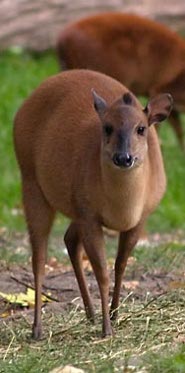 The Natal duiker (Cephalophus natalensis) is a tiny, shy antelope that lives on the east coast of sub-Saharan Africa in the countries of Malawi, Mozambique, Swaziland, South Africa, Tanzania and Kenya. Although there have been reported sightings of natal duikers in Zambia, some researchers believe that these animals may have actually been the similar Harvey's Duiker.
The Natal duiker (Cephalophus natalensis) is a tiny, shy antelope that lives on the east coast of sub-Saharan Africa in the countries of Malawi, Mozambique, Swaziland, South Africa, Tanzania and Kenya. Although there have been reported sightings of natal duikers in Zambia, some researchers believe that these animals may have actually been the similar Harvey's Duiker.The majority of this compact, sturdy animal is a handsome red in color, which explains why it is also sometimes referred to as a red forest duiker or the natal red duiker. The underside of this antelope is slightly lighter in color. White hairs mark the natal duiker's chin and throat areas, and it carries a knob-like crest of hair on the top of its head. This tuft is often darker in color than the rest of the antelope, but other times it is the same red coloring.
Natal duikers typically stand about 40 to 45 centimeters at their shoulder, or about a foot and a half, tall and they are about 75 to 87 centimeters, or about 2 1/2 to 3 feet long, from head to tail. These antelope typically weigh about 14 kilograms, which is equivalent to about 30.86 pounds.
Natal duikers, which have a hunched appearance, prefer living in thick brush near a ready source of water in coastal or riverine forests. The natal duiker can also be found in montane forests, as well as subtropical and tropical shrub lands.
Because natal duikers are extremely wary, they are rarely seen, so there is some dispute as to whether this animal is diurnal or nocturnal. When these antelopes are spotted, they are usually seen traveling alone or in pairs. Occasionally, they can be found in small family groups, as well. Natal duikers are territorial and mark their range with scent markers that are located near this antelope's eyes.
Natal duikers feed upon young shoots, leaves and fruits it finds on the ground. Because of its size, it is preyed upon by most predators, including lions, leopards, hyenas and even large raptors.
Unfortunately, the natal duiker is also extensively hunted by humans, and its flesh is commonly sold as bush meat in local markets. Still, the natal duiker is not considered endangered and it is currently listed as a species of least concern on the IUCN's red list. It is believed by some researchers, that this antelope may eventually disappear in areas where it is not protected, but because its population is fairly stable in protected areas, it probably won't become endangered in the near future.
Picture of the natal duiker by Der Irbis at de.wikipedia, licensed under GFDL and under the Creative Commons Attribution-Share Alike 3.0 Unported license.
Keywords: red
The Natal duiker, natal red duiker, red forest duiker is listed as Conservation Dependent (LR/cd), the focus of a continuing taxon-specific or habitat-specific conservation programme targeted towards the taxon in question, the cessation of which would result in the taxon qualifying for one of the threatened categories below within a period of five years, on the IUCN Red List of Threatened Species
Natal duiker habitats
Forest, Shrubland, Subtropical / Tropical Dry forest and Subtropical / Tropical Dry ShrublandSome facts about the
Natal duiker
Adult weight : 10 kg (22 lbs)
Maximum longevity : 15 years
Litter size : 1

Custom Search